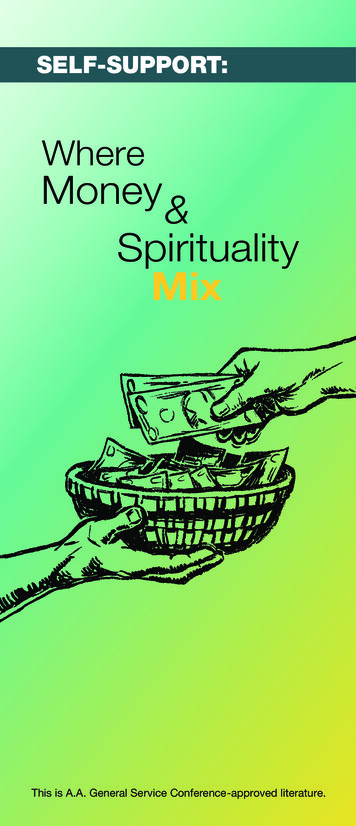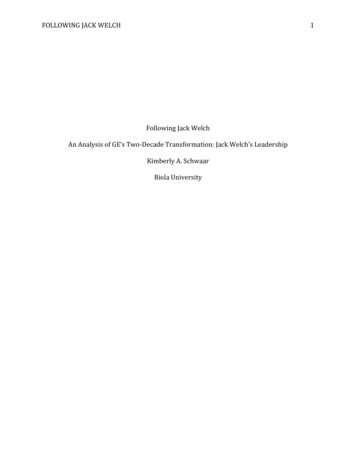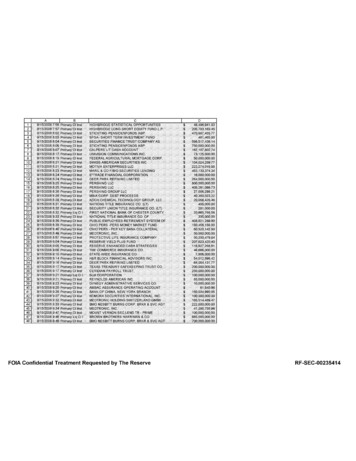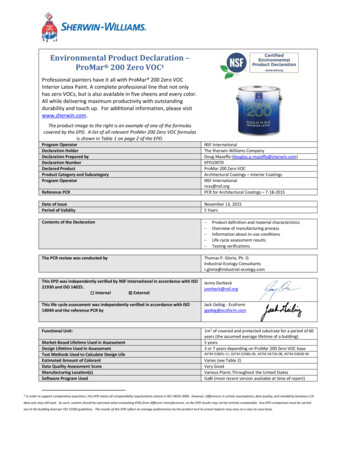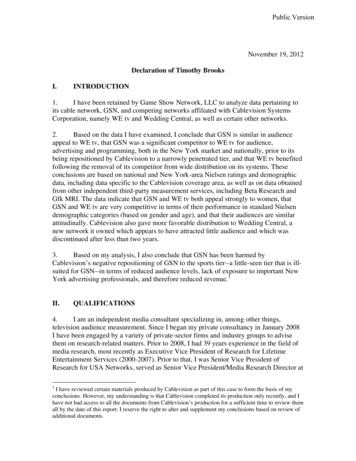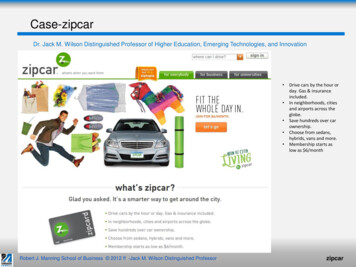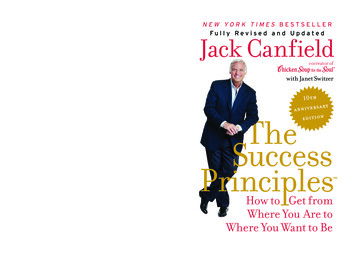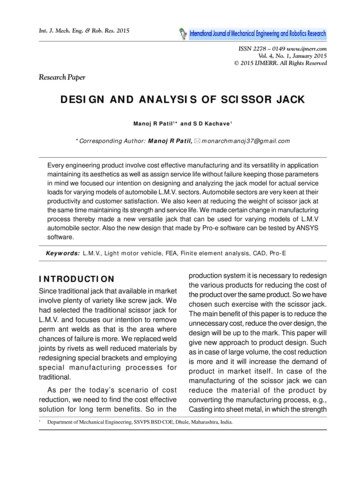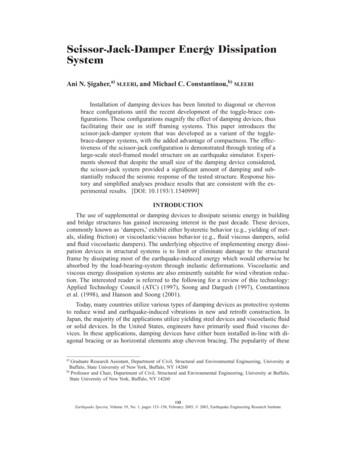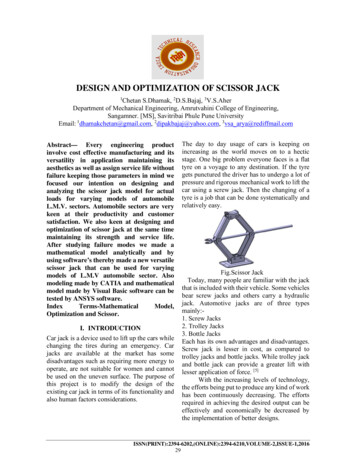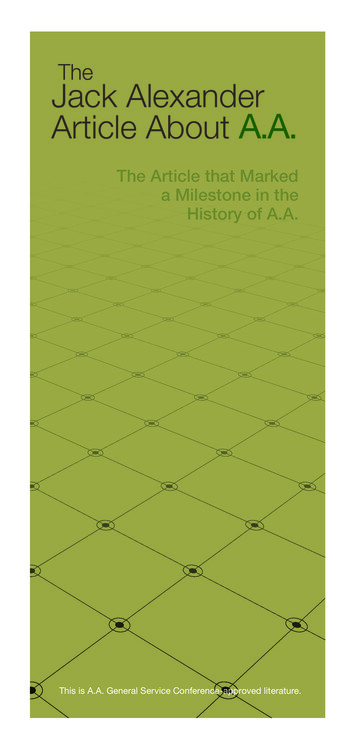
Transcription
TheJack AlexanderArticle About A.A.The Article that Markeda Milestone in theHistory of A.A.This is A.A. General Service Conference-approved literature.
Alcoholics Anonymous is a fellowship of menand women who share their experience, strengthand hope with each other that they may solvetheir common problem and help others to recover from alcoholism. The only requirement for membership is adesire to stop drinking. There are no dues orfees for A.A. membership; we are self-supportingthrough our own contributions. A.A. is not allied with any sect, denomination,politics, organization or institution; does not wishto engage in any controversy; neither endorsesnor opposes any causes. Our primary purpose is to stay sober and helpother alcoholics to achieve sobriety.Copyright by A.A. Grapevine, Inc.;reprinted with permission.Copyright 2017by Alcoholics Anonymous World Services, Inc.All rights reserved.Reprinted by Special Permission ofThe Saturday Evening PostCopyright 1941The Curtis Publishing CompanyAdditional copies available fromAlcoholics Anonymous World Services, Inc.www.aa.orgMail address:Box 459, Grand Central StationNew York, NY 1016314M – 02/19 (PAH)
The Jack AlexanderArticle . . . About A.A.
NOTEPublication of “Alcoholics Anonymous” by JackAlexander in the Saturday Evening Post issue ofMarch 1, 1941, marked a milestone in the historyof this Fellowship.Although one national article had been published previously, the Post report on the handfulof men and women who had achieved sobrietythrough A.A. was largely responsible for the surgeof interest that established the Society on a national and international basis.The Post story is a reminder of A.A.’s de velopment in a relatively short span of years. In 1941,approximately 2,000 men and women were livingthe A.A. program successfully. To day, the number exceeds 2,000,000, and over 61,000 groupsmeet regularly throughout the United States andCanada and in more than 180 countries.In 1941 Jack Alexander reported upon thesense of humility and service that distinguishedthe A.A. program and those who then practicedit. Alcoholics Anonymous has had a tremendousgrowth since that time. But the same awarenessof our need to continue to serve fellow alcoholicsin a spirit of helpfulness and humility remains thecornerstone of our Society.It is in that spirit that this historic article isreprinted for all those members, old and new,who share a common interest in the early days ofAlcoholics Anonymous.5
Readers are reminded that this article was firstpublished in March 1941, when A.A. had beenin existence less than six years. References todates, time sequences, and the number of mem bers in various groups should be read with thisfact in mind.On pages fifteen and sixteen the early helpby John D. Rockefeller, Jr., is described. Thishelp, though modest, was important to A.A.in those early, struggling days. Perhaps evenmore important was “John D.’s” conclusion thatA.A. should pay its own way — a conclusion thatled to the Fellowship’s unique and vital traditionof self-support.Today, A.A.’s world services are whollysup p orted by contributions from A.A. groupsand individuals, and from the sale of booksand pamphlets.The General Service Office is now in larger quarters; it employs both A.A.s and nonalcoholics — equally dedicated. The AlcoholicFoundation has become the General ServiceBoard of Alcoholics Anonymous with twenty-onetrustees, of whom seven are nonalcoholics. Thesimple structure that proved so important to A.A.’sgrowth is much the same as Jack Alexander foundit in 1941.7
Alcoholics AnonymousBY JACK ALEXANDERTsat around the bed of an alcoholicpatient in the psychopathic ward of Philadel phia General Hospital one afternoon a few weeksago. The man in the bed, who was a completestranger to them, had the drawn and slightly stupid look that inebriates get while being defoggedafter a bender. The only thing that was noteworthy about the callers, except for the obvious contrast between their well-groomed appearancesand that of the patient, was the fact that eachhad been through the defogging process manytimes himself. They were members of AlcoholicsAnonymous, a band of ex-problem drinkers whomake an avo cation of helping other alcoholics tobeat the liquor habit.The man in the bed was a mechanic. His visitors had been educated at Princeton, Yale andPennsylvania and were, by occupation, a salesman,a lawyer and a publicity man. Less than a yearbefore, one had been in shackles in the same ward.One of his companions had been what is knownamong alcoholics as a sanitarium commuter. Hehad moved from place to place, bedeviling thestaffs of the country’s leading institutions for thetreatment of alcoholics. The other had spent twenty years of life, all outside institution walls makinglife miserable for him self, and his family and hisemployers, as well as sundry well-meaning relatives who had had the temerity to intervene.The air of the ward was thick with the aromaof paraldehyde, an unpleasant cocktail smellinglike a mixture of alcohol and ether which hospi talssometimes use to taper off the paralyzed drinkerand soothe his squirming nerves. The visitorsseemed oblivious of this and of the depressinghree men9
atmosphere that clings to even the nicest of psychopathic wards. They smoked and talked with thepatient for twenty minutes or so, then left their personal cards and departed. If the man in the bed feltthat he would like to see one of them again, theytold him, he had only to put in a telephone call.Tit plain that if he actually wanted tostop drinking, they would leave their workor get up in the middle of the night to hurry towhere he was. If he did not choose to call, thatwould be the end of it. The members of AlcoholicsAnonymous do not pursue or coddle a malingering prospect, and they know the strange tricks ofthe alcoholic as a reformed swindler knows the artof bamboozling.Herein lies much of the unique strength ofa movement which, in the past six years, hasbrought recovery to around 2,000 men andwomen, a large percentage of whom had beenconsidered medically hopeless. Doctors and clergymen, working separately or together, havealways managed to salvage a few cases. In isolatedinstances, drinkers have found their own methodsof quitting. But the inroads into alcoholism havebeen negligible, and it remains one of the greatunsolved public-health enigmas.By nature touchy and suspicious, the alco holiclikes to be left alone to work out his puzzle, and hehas a convenient way of ignoring the tragedy whichhe inflicts meanwhile upon those who are closeto him. He holds desperately to a conviction that,although he has not been able to handle alcoholin the past, he will ultimately succeed in becominga controlled drinker. One of medicine’s queerestanimals, he is, as often as not, an acutely intelligentperson. He fences with professional men and relatives who at tempt to aid him and he gets a perversesatis faction out of tripping them up in argument.They madeno specious excuse for drinking whichthe troubleshooters of Alcoholics Anonymoushave not heard or used themselves. When one of10here is
their prospects hands them a rationalization forgetting soused, they match it with half a dozen outof their own experience. This upsets him a little,and he gets defensive. He looks at their neat clothing and smoothly shaved faces and charges themwith being goody-goodies who don’t know whatit is to struggle with drink. They reply by relatingtheir own stories: the double Scotches and brandies before breakfast; the vague feeling of discom fort which precedes a drinking bout; the awak ening from a spree without being able to accountfor the actions of several days and the hauntingfear that possibly they had run down someonewith their automobiles.They tell of the eight-ounce bottles of gin hidden behind pictures and in caches from cellar toattic; of spending whole days in motion-pic turehouses to stave off the temptation to drink; ofsneaking out of the office for quickies during theday. They talk of losing jobs and stealing moneyfrom their wives’ purses; of putting pepper intowhiskey to give it a tang; of tippling on bitters andsedative tablets, or on mouth wash or hair tonic;of getting into the habit of camping outside theneighborhood tavern ten minutes before opening time. They describe a hand so jittery that itcould not lift a pony to the lips without spilling thecontents; drinking liquor from a beer stein becauseit can be steadied with two hands, although atthe risk of chipping a front tooth; tying an end ofa towel about a glass, looping the towel aroundthe back of the neck, and drawing the free endwith the other hand, pulley fashion, to advancethe glass to the mouth; hands so shaky they feelas if they were about to snap off and fly into space;sitting on hands for hours to keep them fromdoing this.These and other bits of drinking lore usuallymanage to convince the alcoholic that he is talkingto blood brothers. A bridge of confidence is thereby erected, spanning a gap which has baffled thephysician, the minister, the priest, or the haplessrelatives. Over this connection, the troubleshooters convey, bit by bit, the details of a program11
for living which has worked for them and which,they feel, can work for any other alcoholic. Theyconcede as out of their orbit only those who arepsychotic or who are already suffering from thephysical impairment known as wet brain. At thesame time, they see to it that the prospect getswhatever med ical attention is needed.Mand staffs of institutionsthroughout the country now suggest Alco holics Anonymous to their drinking patients. Insome towns, the courts and probation officers cooperate with the local group. In a few city psychopathic divisions, the workers of Alcohol ics Anonymousare accorded the same visiting privileges as staffmembers. Philadelphia Gen eral is one of these.Dr. John F. Stouffer, the chief psychiatrist, says:“the alcoholics we get here are mostly those whocannot afford private treatment, and this is by farthe greatest thing we have ever been able to offerthem. Even among those who occasionally landback in here again, we observe a profound changein person ality. You would hardly recognize them.”any doctorsThe Illinois Medical Journal, in an editorial lastDecember, went further than Dr. Stouffer, in stating: “It is indeed a miracle when a person who foryears has been more or less constantly under theinfluence of alcohol and in whom his friends havelost all confidence, will sit up all night with a drunkand at stated intervals admin ister a small amountof liquor in accordance with a doctor’s order without taking a drop himself.”This is a reference to a common aspect of theArabian Nights adventures to which Alco holicsAnonymous workers dedicate them selves. Often itinvolves sitting upon, as well as up with, the intoxicated person, as the im pulse to jump out a windowseems to be an attractive one to many alcoholicswhen in their cups. Only an alcoholic can squat onanother alcoholic’s chest for hours with the propercom bination of discipline and sympathy.During a recent trip around the East andMiddle West, I met and talked with scores of12
A.A.s, as they call themselves, and found them tobe unusually calm, tolerant people. Some how, theyseemed better integrated than the average groupof nonalcoholic individuals. Their transformationfrom cop fighters, canned-heat drinkers, and, insome instances, wife beaters, was startling. On oneof the most influential newspapers in the country, Ifound that the city editor, the assistant city editor,and a nationally known reporter were A.A.s, andstrong in the confidence of their publisher.Icity, I heard a judge parole a drunkendriver to an A.A. member. The latter, duringhis drinking days, had smashed several cars andhad had his own operator’s license suspended.The judge knew him and was glad to trust him. Abrilliant executive of an advertising firm disclosedthat two years ago he had been panhandlingand sleeping in a door way under an elevated structure. He had a favorite doorway, which he sharedwith other vagrants, and every few weeks he goesback and pays them a visit just to assure himselfhe isn’t dreaming.In Akron, as in other manufacturing centers,the groups include a heavy element of manualworkers. In the Cleveland Athletic Club, I hadluncheon with five lawyers, an accountant, an engineer, three salesmen, an insurance man, a buyer, abartender, a chain-store manager, a manager of anindependent store, and a man ufacturer’s representative. They were mem bers of a central committeewhich coordinates the work of nine neighborhoodgroups. Cleve land, with more than 450 members,is the big gest of the A.A. centers. The next largestare located in Chicago, Akron, Philadelphia, LosAngeles, Washington, and New York. All told,there are groups in about fifty cities and towns.In anothertheir work, the A.A.s spoke of theirdrunk-rescuing as “insurance” for themselves.Experience within the group has shown, they said,that once a recovered drinker slows up in thiswork he is likely to go back to drinking himself.n discussing13
There is, they agreed, no such thing as an ex-alcoholic. If one is an alcoholic — that is, a personwho is unable to drink normally — one remains analcoholic until he dies, just as a diabetic remains adiabetic. The best he can hope for is to become anarrested case, with drunk-saving as his insulin. Atleast, the A.A.s say so, and medical opinion tendsto support them. All but a few said that they hadlost all desire for alcohol. Most serve liquor in theirhomes when friends drop in, and they still go tobars with companions who drink. The A.A.s tippleon soft drinks and coffee.One, a sales manager, acts as bartender at hiscompany’s annual jamboree in Atlantic City andspends his nights tucking the celebrators intotheir beds. Only a few of those who recover failto lose the feeling that at any minute they maythoughtlessly take one drink and skyrocket off ona disastrous binge. An A.A. who is a clerk in anEastern city hasn’t had a snifter in three and a halfyears, but says that he still has to walk fast pastsaloons to circumvent the old impulse; but he is anexception. The only hang over from the wild daysthat plagues the A.A. is a recurrent nightmare.In the dream, he finds himself off on a rousingwhooper-dooper, fran tically trying to conceal hiscondition from the community. Even this symptomdisappears shortly, in most cases. Surprisingly, therate of employment among these people, who for merly drank themselves out of job after job, is saidto be around ninety percent.One-hundred-percent effectiveness withnon-psychotic drinkers who sincerely wantto quit is claimed by the workers of AlcoholicsAnonymous. The program will not work, they add,with those who only “want to want to quit,” or whowant to quit because they are afraid of losing theirfamilies or their jobs. The effective desire, theystate, must be based upon enlight ened self-interest;the applicant must want to get away from liquorto head off incarceration or premature death. Hemust be fed up with the stark social lonelinesswhich engulfs the uncontrolled drinker, and hemust want to put some order into his bungled life.14
As it is impossible to disqualify all borderlineapplicants, the working percentage of recoveryfalls below the 100-percent mark. According toA.A. estimation, fifty percent of the alcoholicstaken in hand recover almost immediately; twenty-five percent get well after suffering a relapse ortwo; and the rest remain doubtful. This rate of success is exceptionally high. Statistics on traditionalmedical and religious cures are lacking, but it hasbeen informally estimated that they are no morethan two or three percent effective on run-of-themine cases.Although it is too early to state that AlcoholicsAnonymous is the definitive answer to alcohol ism, its brief record is impressive, and it is receiving hopeful support. John D. Rockefeller, Jr.,helped defray the expense of getting it started andhas gone out of his way to get other prominentmen interested.Rockefeller’s gift was a small one, in deference to the insistence of the originators thatthe movement be kept on a volun tary, nonpaidbasis. There are no salaried or ganizers, no dues,no officers, and no central control. Locally, therents of assembly halls are met by passing the hatat meetings. In small communities, no collectionsare taken, as the gatherings are held in privatehomes. A small office in downtown New Yorkacts merely as a clearinghouse for information.There is no name on the door, and mail is receivedanonymously through a post-office box. The onlyincome, which is money received from the saleof a book describing the work, is handled by theAlcoholic Foundation, a board composed of threealcohol ics and four nonalcoholics.In Chicago, twenty-five doctors work hand inhand with Alcoholics Anonymous, contribut ingtheir services and referring their own alco holicpatients to the group, which now numbers around200. The same cooperation exists in Clevelandand to a lesser degree in other cen ters. A physician, Dr. W.D. Silkworth, of New York City, gavethe movement its first encouragement. However,15
many doctors remain skep tical. Dr. FosterKennedy, an eminent New York neurologist, probably had these in mind when he stated at a meeting a year ago: “The aim of those concerned in thiseffort against alcoholism is high; their success hasbeen con siderable; and I believe medical men ofgoodwill should aid.”The active help of two medical men of good will,Drs. A. Wiese Hammer and C. Dudley Saul, hasassisted greatly in making the Philadel phia unitone of the more effective of the younger groups.The movement there had its beginning in an offhand way in February, 1940, when a businessman who was an A.A. convert was transferred toPhiladelphia from New York. Fearful of backsliding for lack of rescue work, the newcomer rounded up three local barflies and started to work onthem. He got them dry, and the quartet began ferreting out other cases. By last December fifteenth,ninety-nine alcohol ics had joined up. Of these,eighty-six were now total abstainers — thirty-ninefrom one to three months, seventeen from three tosix months, and twenty-five from six to ten months.Five who had joined the unit after having be longedin other cities had been nondrinkers from one tothree years.Aend of the time scale, Akron, whichcradled the movement, holds the intra muralrecord for sustained abstinence. Accord ing to arecent checkup, two members have been ridingthe A.A. wagon for five and a half years, one forfive years, three for four and a half years, one forthe same period with one skid, three for threeand a half years, seven for three years, three forthree years with one skid each, one for two and ahalf years, and thirteen for two years. Previously,most of the Akron ites and Philadelphians had beenunable to stay away from liquor for longer than afew weeks.In the Middle West, the work has been almostexclusively among persons who have not ar rived atthe institutional stage. The New York group, whichhas a similar nucleus, makes a sideline specialty of16t the
committed cases and has achieved striking results.In the summer of 1939, the group began working on the alcoholics confined in Rockland StateHospital, at Orange burg, a vast mental sanitariumwhich gets the hopeless alcoholic backwash of thebig popula tion centers. With the encouragementof Dr. R.E. Blaisdell, the medical superintendent,a unit was formed within the walls, and meetingswere held in the recreation hall. New York A.A.swent to Orangeburg to give talks, and on Sundayevenings, the patients were brought in state-ownedbuses to a clubhouse which the Manhattan grouprents on the West Side.Last July first, eleven months later, records keptat the hospital showed that of fifty-four patientsreleased to Alcoholics Anonymous, seventeen hadhad no relapse and fourteen oth
a Milestone in the History of A.A. . Our primary purpose is to stay sober and help . other alcoholics to achieve sobriety. . approximately 2,000 men and women were living the A.A. program successfully. Today, the num-ber exceeds 2,000,000, and over 61,000 groupsFile Size: 843KBPage Count: 32People also search forjack alexander article aajack alexander saturday evening postaa articlejack anderson aa articlejack anderson saturday evening postny times aa article
